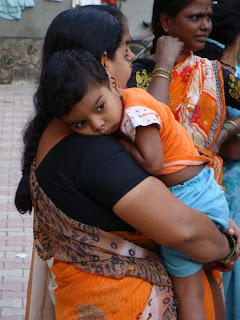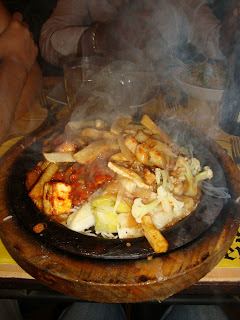Sandhya’s family is Buddhist, and since Susan and Jenny were in Goa for the long weekend, she invited me to her house for the festival. Her brother-in-law also just completed the remodeling of his house, so they also had a puja (payer ritual) to celebrate that.
I got there at about noon, and all the houses around the housing society (neighborhood) had a Rangoli outside their front doors. They are made out of a sand-like material that, in this part of the country, is made of died, crushed rock. Rangolis come in different shapes, sizes and colors.

Then we went over to the brother-in-law’s house where they were having the puja. Everyone in the extended family was there. They sat on the floor in two rooms; the women were in the room where the table was set up with a Buddha statue and candles, and the men were in the room next to that. They all chanted and sang some prayers, and then we passed a long string around that everyone held on to and they sang another prayer. After the puja we all went out for a buffet lunch in the backyard. It was really good, especially the gulab jamun (which is quickly becoming my favorite Indian sweet) and the puri (a crispy, puffed up, deep fried bread); there were also papads, a vege curry, a dal, rice and palak bhaji (spinach deep fried in a chick pea batter).
I made friends with lots of the kids there, especially Sandhya’s niece Siddhi and her daughter Aakanksha. Siddhi is learning English at school and is very good at it. Aakanksha goes to a Marathi school and at first she was too shy to try the little bit of English she knows, but she got more comfortable as the day went on. Here is Siddhi with her lunch.

Here I am with some of Sandhya’s nieces and nephews. They have a very big extended family and I think they all live in the same housing society, which Sandhya’s grandfather founded in 1956. It’s an all Buddhist community that was established so that the workers in a local munitions factory didn’t have to go live in the slums when they retired. Six of these kids live in Sandhya’s household: the three girls and three of the boys.

At the end of the day Sandhya’s husband took me home. I showed him our flat and he was amazed that we each have our own room; I think they share about three or four people to a room in their house. I also showed him some pounds because he has never seen any foreign currency, and he was really happy.































